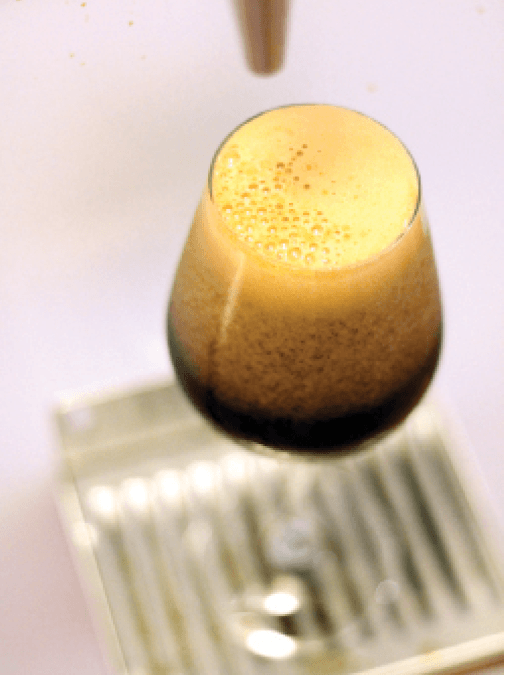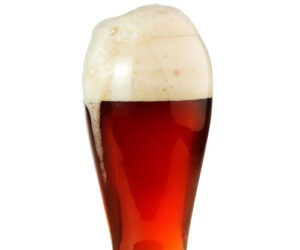New Pumpkin Beer Styles
The leaves will soon be changing, the air is getting crisp, and pub brewers everywhere cringe as they clean pumpkin goo from their mash tuns for the eighth time already! Thirty years ago this now ubiquitous orange-hued caramel-malt-heavy pumpkin-pie-spiced style was first brewed by Buffalo Bill’s Brewery in Hayward, California. Since that time it has spread around the world. Regrettably, most versions provide little to balance the warming spices other than malty-sweetness. Much like my annual slice of pumpkin pie, I look forward to these pumpkin ales, but one bottle around Thanksgiving is usually enough.
Pumpkins impart a subtle fruity-vegetal flavor. On a commercial-scale, adding enough flesh to shine through is a time-consuming, expensive, and messy endeavor. A pumpkin on the label is often just an excuse for cinnamon and nutmeg in the kettle. Luckily, obtaining above-threshold pumpkin flavor is less of a chore for a single batch of homebrew.
Pumpkin ale is an expanding category, with brewers playing the spices against roasted grain, or toning them down to leave more room for gourd; they are adding other squash varieties, and contributing unexpect
ed spicy flavors (including from Saccharomyces cerevisiae). Much as the once singular style of IPA has spawned session, black, New England, and countless other variants, so too is pumpkin ale slowly hybridizing and expanding!
Pumpkin and Roast
As the legions of PSL (pumpkin spice latte) drinkers know, pumpkin pie spices (i.e., cinnamon, allspice, nutmeg, ginger, clove, and mace) meld wonderfully with roasted coffee. Two of my favorite commercial pumpkin beers exhibit this same synergy with spice and roasted grain: St. Arnold Brewing Co. (Houston, Texas) Pumpkinator, and Cape Ann Brewing Co. (Gloucester, Massachusetts) Fisherman’s Pumpkin Stout. For a similar effect, simply add one pound of the dark grain(s) of your choice per five gallons (0.45 kg in 19 L) to the mash/steep to transform your classic orange pumpkin beer recipe into a roasty dynamo!
If roasted grains aren’t enough, follow the Midnight Sun Brewing Co. (Anchorage, Alaska) T.R.E.A.T. template and add cocoa nibs to create a flavor reminiscent of a chocolate-pumpkin muffin. Or close the loop like Elysian
Brewing Co. (Seattle, Washington) Punkuccino, and steep two ounces of freshly-roasted whole coffee beans in 5 gallons (56 g in 19 L) of pumpkin-spiced brown ale for 24 hours before packaging. I would avoid resorting to pumpkin-spiced coffee beans in favor of controlling the coffee and spices independently.
Pumpkin and Pale
Rather than playing the spices off malt, pare back the malt and spice to create a more drinkable variant. Starting with a yellow base and a touch of spice is especially nice if you live in a climate where fall arrives late.
When I visited Commonwealth Brewing Co. (Virginia Beach, Virginia) to brew a collaborative sour brown, I sampled their Pumpkin Juice, a pumpkin cream ale served on beer gas. The spicing was subtle enough to make it pint-able. Brewer Greg Fleehart commented, “I aim for 10–15 IBU below what I would normally find in the base style. Plus adjuncts like wheat, oats, rye, or even dextrin malts can boost body and soften the spice bitterness.”
Another option is the white or golden “stout” route. These rely on coffee and/or chocolate for roast, while creating a creamy body with oats, lactose, and beer gas for an optical illusion beer. They can be gimmicky, but the mellow roast would let the pumpkin play the starring role.
Pumpkin and Acid
I briefly discussed squash-flavored sour ales in my book American Sour Beers. As weird as the idea may sound, pumpkin sours are some of my favorites! The interplay of the earthy-fruit with acidity, firm maltiness, and faint spicing can be wonderful given the right balance. Alpine Brewing Co. (Alpine, California) 2009 Ichabod still stands at the top of the sour-pumpkin heap for me!
Suggestions based on my two attempts:
1. Start with a malty red/brown.
2. Keep acidity tame.
3. Retain some sweetness and body.
4. Add the roasted squash to the aging beer for the last few months.
5. Lightly spice at the end of the boil, add more if needed at packaging.
Other Pumpkin Ideas
Pumpkin beer need not be sessionable. Randy Mosher included the recipe for his Headless Horseman Pumpkin Barley Wine in Radical Brewing. Almanac Brewing (San Francisco, California) creates Heirloom Pumpkin by blending a Brandy-and rye-barrel-aged pumpkin barleywine with a fresh spiced barleywine to create a range of flavors that no single batch could possess. Avery Brewing Co. (Boulder, Colorado) Rumpkin pushes pumpkin ale even further, to 18% ABV, fortified by rum-barrel aging. For a similar effect at home without the barrel, dose the spirit of your choice directly into your finished imperial pumpkin ale to taste!
I’ve tried a few surprisingly delicious homebrewed dark Belgian beers (dark saison, dubbel, and quadrupel) brewed with pumpkin to add an earthy edge to the yeasty-spice. These creations work best when you select a yeast strain and fermentation temperature profile that limits the banana flavor, focusing on the pepper and spice. Rather than typical pie spices, try a hint of coriander or fresh ginger.
While the 2015 Beer Judge Certification Program (BJCP) Style Guidelines introduced a half dozen new IPA sub-categories, conspicuously missing was pumpkin IPA. I’d say leave it that way, but then I didn’t think I’d enjoy coffee IPA as much as I do! I’d also avoid pale lagers because they don’t have enough backbone to stand up to spices (a doppelbock on the other hand could be wonderful).
Pumpkin is One Squash
While a pumpkin on a label may look festive, it isn’t the easiest squash to deal with given seasonal availability, thick skin, hollow-sphere of flesh, and mass of seeds and fibrous strands. Butternut squash has greater year-round availability and is easier to peel and cube. I prefer the more assertive flavor as well. Acorn squash is nuttier and its small stature makes it easier to deal with. The intensely earthy kabocha would be another interesting choice, especially with Belgian yeast.
If it just has to be pumpkin, pass on the jack-o’-lantern and use small sugar “pie” pumpkins. Whatever the gourd, I use a vegetable peeler for skin removal, a spoon for seed removal, and a chef’s knife for chopping.
The options for cooking fall into two categories: Dry (roasting, grilling) and wet (steaming, boiling). Dry heat creates toasty flavors by causing the sugars and proteins to react via the Maillard reactions. You can even coat the pieces with brown sugar and spices. If you want to play up the vegetal flavor of the squash, opt for wet heat. Canned pumpkin (not pie filling) is a minimal-effort alternative, but spread it out on a baking sheet in the oven at 350 °F (175 °C) for 20 minutes to drive off the tinny-canned flavor.
I’ve had my best results adding cooked squash directly to the boil for quick-turnaround beers. Most squash varieties contain minimal starch (for example, raw pumpkin is only 3.8% non-sugar carbohydrates, as noted with other squash varieties in the chart on page 97), so mashing
with enzymatic malts is not strictly required. Boiling effectively extracts flavor without a risk of sticking the sparge. If you want the taste to come through, add at least one pound per gallon (0.12 kg/L), and as much as double that for dark beers!
Spicing
Like many brewers, you may not want to highlight or even bother with squash. No sense in wasting effort! Classic spicing can enhance with or without squash.
Commonwealth’s Greg Fleehart suggests “A quarter to half of your spice blend (minus cinnamon) in whirlpool, the remaining plus your cinnamon as a ‘dry hop’ addition.” Fleehart advocates a light hand with clove because too much can make the beer taste like cider.
While prepackaged pumpkin pie spice is an option, I prefer to blend my own. Here’s the combination I used for my most recent 5 gallons (19 L) of chocolate pumpkin porter: 1.5 tsp. (7.4 mL) cinnamon, 0.5 tsp. (2.5 mL) nutmeg, 0.5 tsp. (2.5 mL) dried ginger, 0.25 tsp. (1.25 mL) allspice, and 5 cloves cinnamon.
A vanilla bean in the fermenter enhances the perception of sweetness as well. There are even breweries rumored to add graham cracker “flavoring” to replicate the pie crust; do with that information what you will . . .
Don’t constrain yourself to the beer equivalent of pumpkin pie. Take a step out of the orange-comfort-zone and see what spices suit squash! I’ve had pumpkin ales with chai masala, chili peppers, and perhaps strangest of all, no spices!
Sources:
• www.ars.usda.gov/SP2UserFiles/Place/80400525/Data/SR/SR28/reports/sr28fg11.pdf




